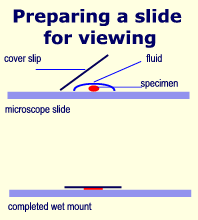Specimen needs to be as thin as possible
Before any specimen can be examined under the microscope, a slide has to be prepared. No matter how good your microscope is, the final image can only be as good as the slide you are viewing, so proper preparation is important.
A normal compound microscope works by passing light up through the viewed specimen, so it is important that the sample or specimen is a thin as possible. This means working with relatively small amounts of algae, mucus, sediment or whatever. This is particularly important when viewing mucus sample as some of the smaller, transparent parasites might not be seen if the preparation is too thick.

Slide and cover glass
Ideally a new slide and cover glass should be used for each preparation, but in practice slides and slips will be re-used many times. In which case it is important that they are clean and free of smears ( cleaning with alcohol will help remove smears – propan-2-ol from a chemist or drug store).
- The specimen is placed, together with one drop of pond water onto the centre of a clean slide. Do not use tap water or distilled water as these may kill any parasites present. If the specimen is thick, use a seeker needle to gently spread it as thin as possible.
- A glass or plastic cover slip is then lowered gently on top making sure that no air bubbles are trapped. The best way to place a cover slip is to hold two opposite edges between first finger and thumb. Holding the slip at a 45o angle, place the bottom edge on the slide just to one side of the specimen and then slowly lower the cover slip until it is flat. You can use a seeker needle to help lower the slide by placing it under the cover glass and slowly lowering it into position
- Once the cover slip is in position apply a small amount of pressure with a seeker needle to spread the sample under the slip and squeeze out any air. Don’t apply too much pressure; just enough to spread the sample. Do not use your finger as a finger print may contaminate the cover glass.
- Practice makes perfect – so try making slides of all sorts of things; blanket weed, algae, mulm etc.
